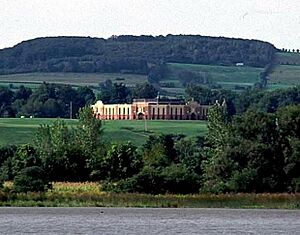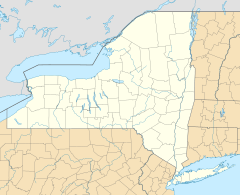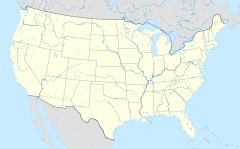Auriesville, New York facts for kids
Quick facts for kids
Auriesville, New York
|
|
|---|---|
| Country | United States |
| State | New York |
| County | Montgomery |
| Town | Glen |
| Elevation | 312 ft (95 m) |
| Time zone | UTC-5 (Eastern (EST)) |
| • Summer (DST) | UTC-4 (EDT) |
| ZIP Code |
12016
|
| Area code(s) | 518 |
| GNIS feature ID | 942705 |

Auriesville is a small community, called a hamlet, located in the northern part of New York State. It is about 41 miles west of Albany, the state capital. This area is known for its rich history, especially its connections to the Mohawk people and early European settlers.
For a long time, Auriesville was believed to be the site of an important Mohawk village called Ossernenon. This village was where French Jesuits (a group of Catholic missionaries) tried to establish a mission in the 1600s. However, conflicts with French colonists led the Mohawk to destroy the mission around 1684. The name "Auries" is thought to come from the last Mohawk person known to have lived there, and later settlers named the village after him.
Since the late 1800s, many Catholics have believed Auriesville was the exact spot where Jesuit missionaries faced great hardship in the 1640s. Because of this belief, the National Shrine of the North American Martyrs was built here in 1930. However, modern archaeologists, who study ancient cultures, have found evidence suggesting that the actual Ossernenon village was located about nine miles west of Auriesville, along a different part of the Mohawk River. This archaeological site is now called the Bauder site. So, while Auriesville is a place of great historical and religious importance, its direct link to Ossernenon is still a topic of discussion among historians and archaeologists.
Contents
Welcome to Auriesville!
Auriesville is a small, quiet community in Montgomery County, New York. It's a place where history comes alive, especially when you learn about the Mohawk people who lived here long ago and the European settlers who arrived later. The area around Auriesville has been home to many important events that shaped the history of New York State and even North America.
A Place of History and Mystery
For many years, people thought Auriesville was the exact location of Ossernenon, a significant Mohawk village. This idea became popular in the late 1800s, especially among Catholic historians. They wanted to pinpoint the spot where several Jesuit missionaries faced great hardship and died in the 1640s. Ossernenon was also known as the birthplace of Kateri Tekakwitha, a Mohawk woman who became a very important figure in the Catholic Church.
The Mohawk People and Early Settlements
The Mohawk people were a powerful Native American nation, part of the larger Iroquois confederacy. They lived in villages along the Mohawk River for hundreds of years. These villages often moved every few decades as the soil for farming became less fertile. When a village moved, the people often took its name with them.
Archaeologists, like Dean R. Snow and Donald A. Rumrill, have carefully studied the land. They believe that the original Ossernenon village was actually about nine miles west of present-day Auriesville. This site is now known as the Bauder site. This research helps us understand the true locations of these ancient settlements.
The Story of Kateri Tekakwitha
Kateri Tekakwitha is a very special person in history. She was born in Ossernenon around 1656. She became known for her strong faith and was later called the "Lily of the Mohawks." In 2012, she was recognized as a saint by the Catholic Church, becoming the first Native American to receive this honor. More than 2,000 Native Americans, many of them Mohawk, traveled to Rome for this important event.
Kateri lived in a Mohawk village called Caughnawaga during her childhood. Archaeologists have identified this village as a new settlement founded in 1659 on the north side of the Mohawk River, at what is now called the Freeman site. Later, the village moved again to a nearby spot, now known as the Fox Farm site. These sites are both west of the modern town of Fonda.
The Jesuit Missionaries and Ossernenon
The story of Ossernenon is closely tied to the arrival of French Jesuit missionaries in the 1600s. These missionaries traveled from New France (now Canada) to share their faith with the Mohawk people.
Early Encounters and Challenges
Three Jesuit missionaries, Saint René Goupil, Saint Isaac Jogues, and Saint Jean de Lalande, are particularly remembered. They faced many dangers while working among the Mohawk. Goupil died in 1642, and Jogues and Lalande died in 1646. They were held captive and treated harshly by some Mohawk warriors at Ossernenon.
In 1642, Jogues and Goupil were captured and brought to Ossernenon. Goupil died later that year. After several months, Jogues was rescued by Dutch traders from Fort Orange (which is now Albany), with help from a Protestant minister named Johannes Megapolensis, who had good relationships with the Mohawk. Jogues then returned to France.
Jogues later returned to Quebec as a missionary. In 1646, he went back to Ossernenon on a peace mission with Lalande, a young Jesuit helper. Sadly, Jogues died on October 18, 1646, and Lalande died the next day while trying to retrieve his friend's body.
The Search for Ossernenon's Location
After the Mohawk village of Ossernenon was attacked by French forces around 1666, its exact location became lost over time. The French attack was a response to earlier conflicts and aimed to make the Mohawk agree to accept Jesuit missionaries. For many years, historians debated where Ossernenon truly was.
In the 1800s, some historians believed that present-day Auriesville was the site of Ossernenon. They based this on old maps and letters from the missionaries, which described Ossernenon as being on the south side of the Mohawk River and west of Schoharie Creek. They thought they recognized landmarks described by Jogues.
However, as mentioned earlier, modern archaeological studies in the late 1900s have provided new information. These studies, based on careful excavations and analysis of historical documents, suggest that Ossernenon was actually located about nine miles west of Auriesville, at the Bauder site. This shows how new discoveries can change our understanding of history!
The National Shrine of the North American Martyrs
Even with the archaeological findings, Auriesville remains a very important place for many people. In 1884, a priest named Joseph Loyzance bought land on a hill in Auriesville. He built a small shrine dedicated to "Our Lady of Martyrs." He led the first pilgrimage there on August 15, 1884, which was also the anniversary of Isaac Jogues' capture in 1642. Four thousand people joined this first pilgrimage.
A Place for Pilgrimage
Over the years, many Catholic churches adopted the tradition of visiting Auriesville in the summer. Thousands of people would gather there to pray and participate in religious services. To protect the area, the Catholic Church bought more land. After Isaac Jogues was made a saint in 1930, the church built the National Shrine of the North American Martyrs at this site. This shrine honors Jogues and other Jesuit missionaries from the French colonial period.
The shrine now includes a large coliseum-sanctuary that can seat up to 6,000 worshipers. The property covers more than 400 acres. It serves as a significant spiritual center and a place where people can reflect on the history of faith and courage in early North America.
See Also
- North American Martyrs
- Early history of Upstate New York



